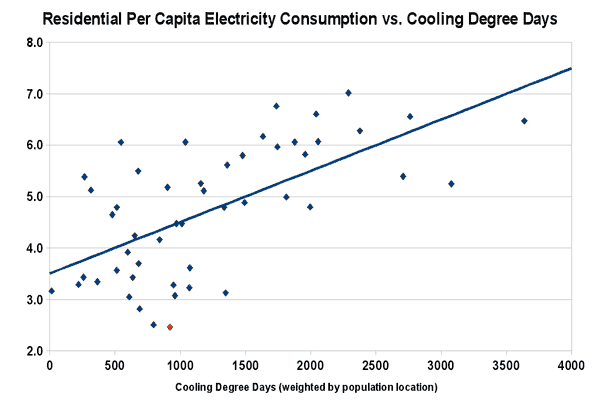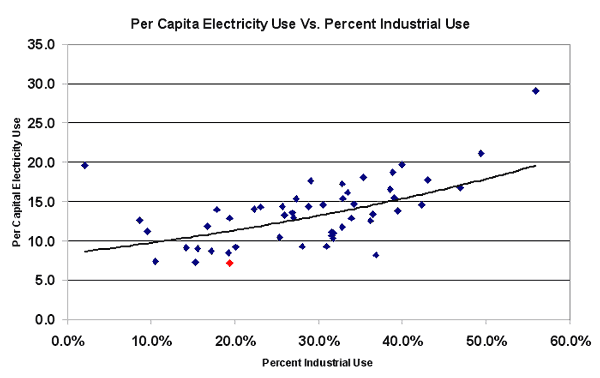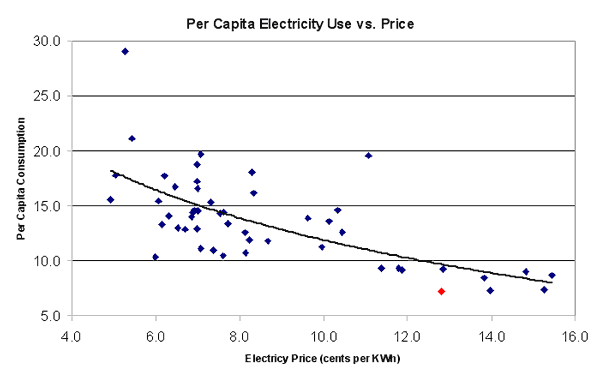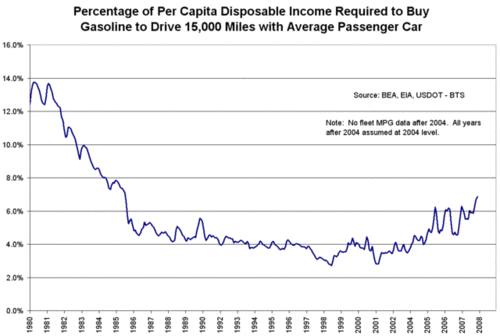I have an innate confidence in technology. For example, while I understand solar to be uneconomic for powering my house today, I fully expect that to change. I look forward to the day, not that far in the future, when I can take my Arizona house off the grid, at least during the day.
In contrast, though, it may be that wind power can't be fixed, in large part due to its inherent unpredictability. Sure, solar has a problem as well, in that it doesn't work at night. But at least the times when solar is off here in Arizona (ie when it is dark) are predictable and coincide with lower load periods. Wind is utterly unpredictable and variable, and its peaks and troughs are unrelated to peaks and troughs in electricity demand.
So, if the grid is to reliably supply sufficient power to meet demand, wind must have a backup. And there is the rub. Because just about every technology that might currently be used as a backup takes a really, really long time to start up. Small gas turbines can be producing electricity from a cold stop pretty quickly, but a large coal-fired power plant can take days to go from a cold stop to producing electricity. This is in part because there are a series of steps where A has to precede B which must come before C to start plants up, and partially just because immediately heating the whole system up would cause the plant to blow up just from the thermal stresses.
So, to back up wind power, traditional fossil fuel plants have to be kept warmed up with turbines spinning. This means that fossil fuels are burned but no electricity is produced. I mentioned in a previous post that the largest utility in Germany estimated that 48,000MW of wind capacity was in fact allowing the shut down of just 2000MW of traditional fossil-fuel powered capacity.
A recent article in the National Post argues the Danes are seeing absolutely no substitution from their substantial investment in wind.
There is no evidence that industrial wind power is likely to have a significant impact on carbon emissions. The European experience is instructive. Denmark, the world's most wind-intensive nation, with more than 6,000 turbines generating 19% of its electricity, has yet to close a single fossil-fuel plant. It requires 50% more coal-generated electricity to cover wind power's unpredictability, and pollution and carbon dioxide emissions have risen (by 36% in 2006 alone).
Flemming Nissen, the head of development at West Danish generating company ELSAM (one of Denmark's largest energy utilities) tells us that "wind turbines do not reduce carbon dioxide emissions." The German experience is no different. Der Spiegel reports that "Germany's CO2 emissions haven't been reduced by even a single gram," and additional coal- and gas-fired plants have been constructed to ensure reliable delivery.
Indeed, recent academic research shows that wind power may actually increase greenhouse gas emissions in some cases, depending on the carbon-intensity of back-up generation required because of its intermittent character.
It probably comes as no surprise that the Danes have the highest electricity costs in Europe. The article goes on to call wind power in the US a "huge corporate welfare feeding frenzy."
Update: Well, the Danish wind industry certainly seems to be in good hands (via Tom Nelson):
Ditlev Engel, president and chief executive of the Danish wind-energy company Vestas, said anecdotal evidence about birds being caught in turbine blades and other environmental horror stories do not usually hold up under scrutiny.
"Do people think it's better all those birds are breathing CO2? I'm not a scientist, but I doubt it," said Engel, whose company is expanding its U.S. manufacturing and distribution operations. "Let's get the facts on the table and not the feelings. The fact is, these are not issues."
LOL - Nothing like a paragraph that simultaneously includes the phrase "Let's get the facts on the table" with the hypothesis that a couple hundred ppm increase in CO2 concentrations hurts birds. By the way, from the same article, a lot of discussion of the environmental impact of renewables due to their out-sized use of land. Clearly an issue for solar and wind, and possibly for others:
One of the biggest challenges renewable-energy projects pose is that they often take up much more land than conventional sources, such as coal-fired power plants. A team of scientists, several of whom work for the Nature Conservancy, has written a paper that will appear in the journal PLoS One showing that it can take 300 times as much land to produce a given amount of energy from soy biodiesel as from a nuclear power plant. Regardless of the climate policy the nation adopts, the paper predicts that by 2030, energy production will occupy an additional 79,537 square miles of land.
I am always amazed at the number of environmentalists that laud the Brazilian ethanol push, given the out-sized effect that industry has had in carving up the Amazon rain forest. As a disclosure, I am a member of the Nature Conservancy, and wild land preservation is my environmental interest of choice, though I prefer to pursue it through private means (ie via private purchases of land for conservation purposes). The Nature Conservancy used to spend most of its money for this purpose, though of late it has diverged, as so many environmental groups have, into lobbying government to force people to achieve its ends for them rather than to pursue these ends through non-coercive means.




